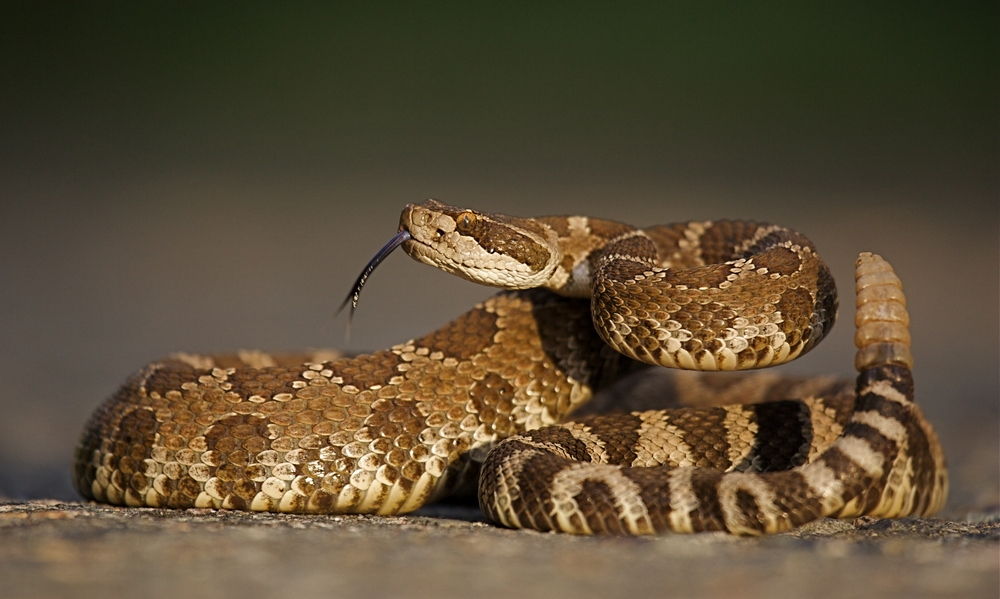
Utah, also known as Snake Country, is the home of many different species of snakes. From one border to another, from mountain top to desert valley, there are high chances to encounter a snake in Beehive County.
Scientists report 31 snakes live in Utah, but only 7 of them are venomous. The other 24 species are quite harmless and nocturnal, so you might scare them instead of them threatening you.
Snakes are salient to the environment, so the wildlife laws in Utah prevent harming or killing snakes. You can have snakes as pets if you get a special license from the government.
This guide aims to give you a broad list of all the 31 snakes in Utah, with photo descriptions and where you can find them.
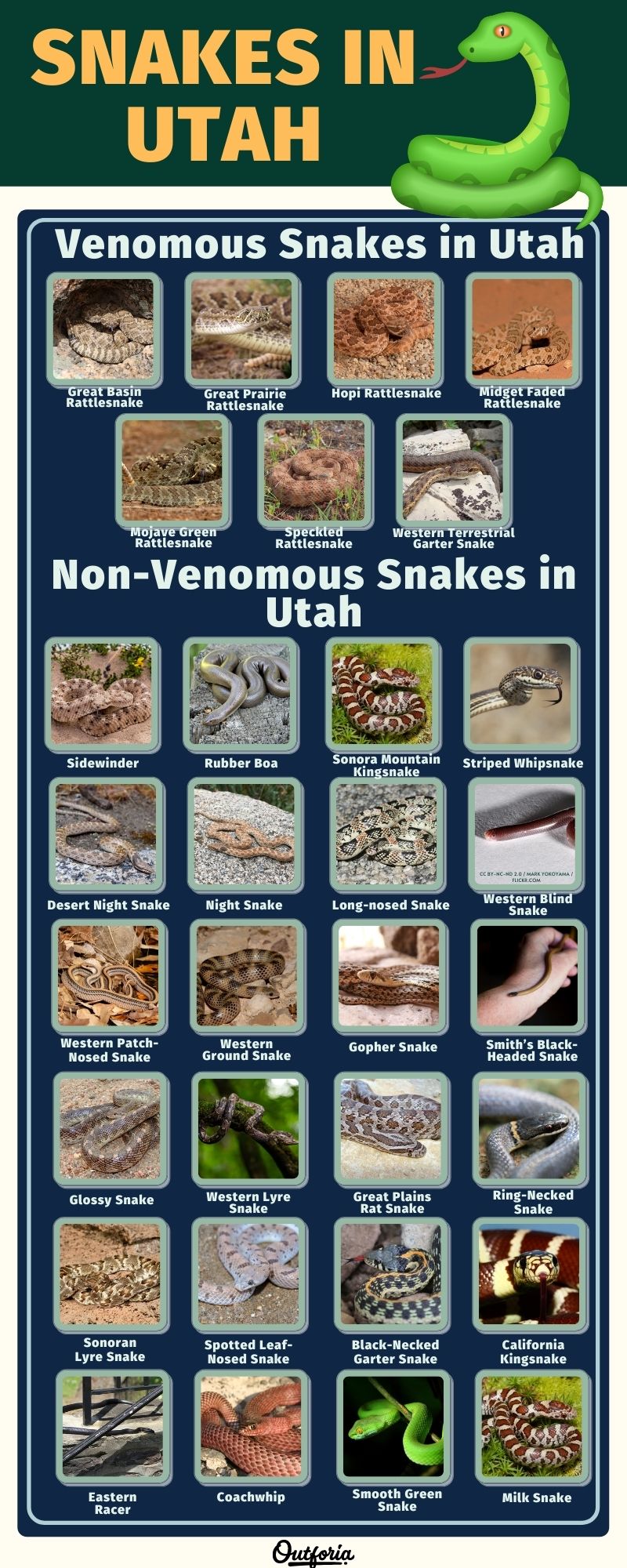
Share This Image On Your Site
<a href="https://outforia.com/snakes-in-utah/"><img style="width:100%;" src="https://outforia.com/wp-content/uploads/2022/03/Snakes-in-Utah-infographics-03262022.jpg"></a><br>Snakes in Utah Infographic by <a href="https://outforia.com">Outforia</a>You May Also Like: These Are The Things You Need To Know About 28 Snakes in Colorado with Photos, Infographics, Facts, and more!
Venomous Snakes in Utah
The majority of venomous snakes in Utah are rattlesnakes. They have triangular heads and vertical eye pupils. As their name suggests, they also have rattles on their tales and make a loud, distinct rattle sound.
1. Great Basin Rattlesnake
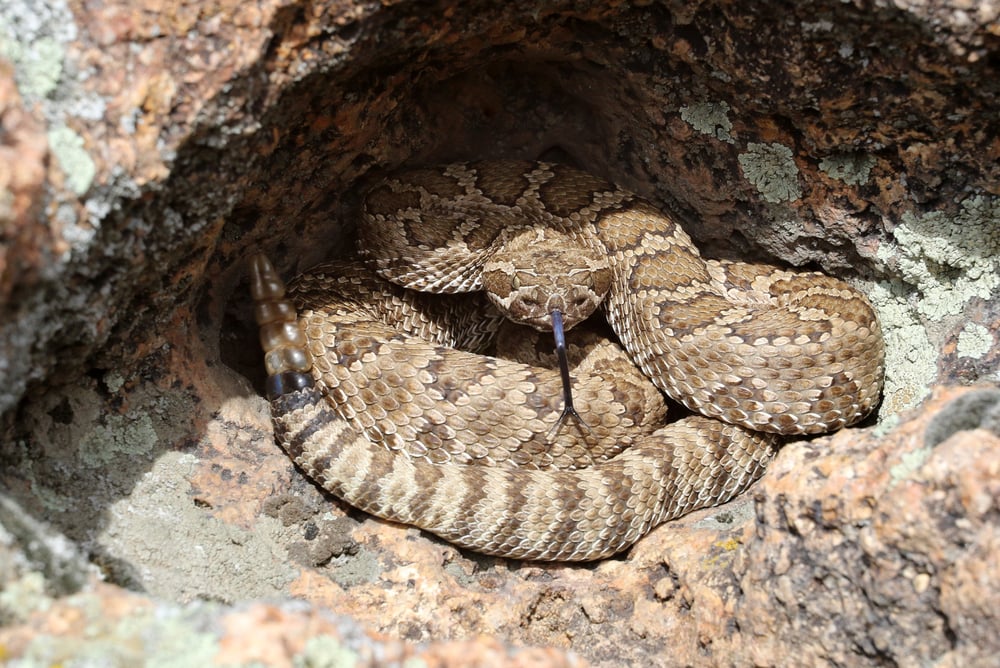
The Great Basin Rattlesnake inhabits the Great Basin region of western Utah and lives in various habitats. They can be found in trees and hiding in shrubs as they prefer dry areas with no foliage.
This species has quite a mix of colors from gray, brown, and green with dark blotches on its back. An adult snake can reach up to 48 inches (121cm), and its average lifespan is 17 years. The Great Basin Rattlesnake is a venomous snake and uses this for hunting its prey. They often stay curled and wait to ambush their food. Their heightened sense of smell and night vision helps them be a great hunter.
They can easily feed on small animals like rodents, birds, bird eggs and other reptiles. Their main predators are birds of prey like hawks.
2. Great Prairie Rattlesnake
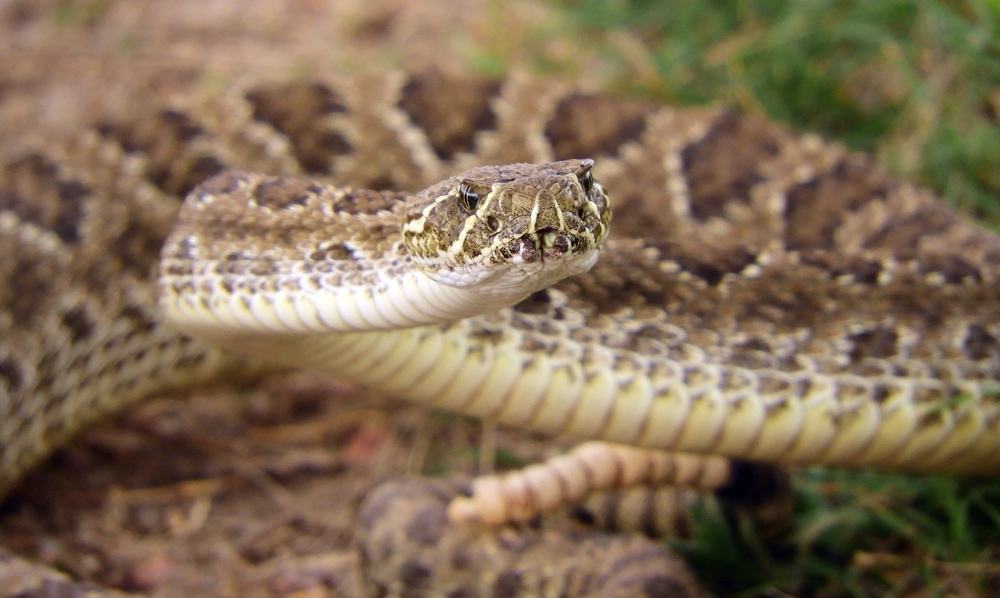
This rattlesnake is a big one as it reaches up to 3.3 ft. (1m). You can find them in Southeastern Utah, although it’s best to leave it alone as it is highly venomous.
It is really hard to distinguish the sexer or rattlesnakes, but as a rule of thumb, male rattlesnakes have a longer tail than females. When the mating season starts, females lay up to 20 eggs.
You can find this species on land but they can also climb trees if they need to ambush their prey. They usually subdue and eat their food in one bite.
3. Hopi Rattlesnake
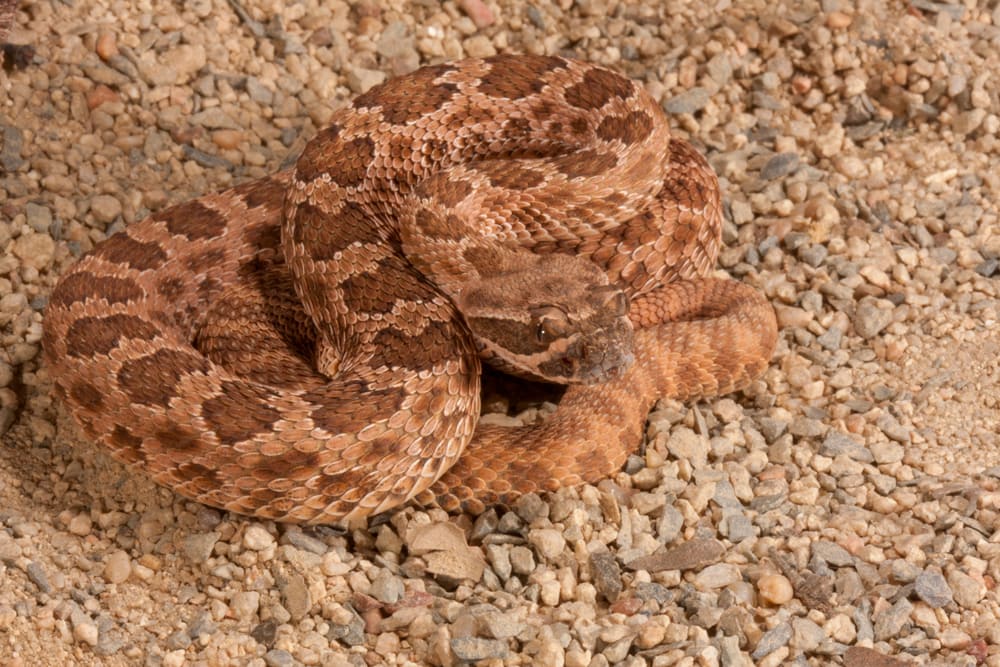
This snake gets its name from the Native American Hopi tribe, found in Arizona. The Hopi Rattlesnake is the smallest rattlesnake living in Southern Utah. They look similar to the Prairie rattlesnake, and they live in the same range, but you can distinguish them by their size.
The Hopi rattlesnake is nocturnal, and in the daytime, it hides from predators. This species is also not a fan of heat, so they usually hunt at night or early mornings. They like to eat small animals or lizards.
They are venomous snakes and their toxins contain both hemotoxic and neurotoxic properties which on rare occasions can be deadly for humans.
4. Midget Faded Rattlesnake
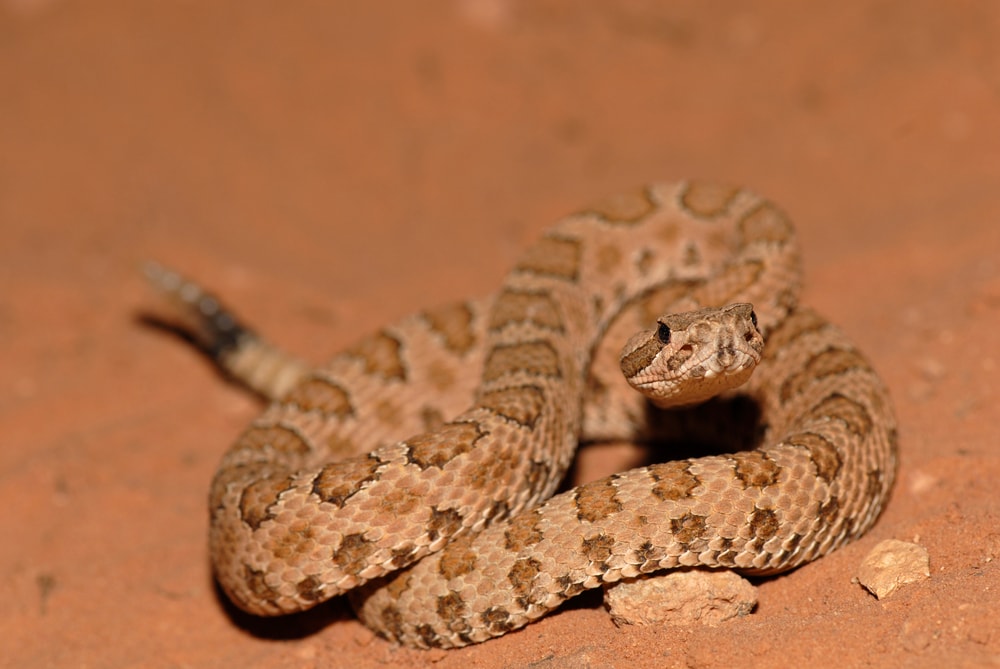
Although the Midget Faded Rattlesnake is very small it has the most potent venom out of all western rattlesnakes, the most potent in North America. It has neurotoxic properties that attack the nervous system of its prey.
They like to hunt at night, and they usually go for small animals and lizards. If this snake feels threatened, it will lift up its head and rattle its tail as a warning. If its aggressor doesn’t back away, the snake will definitely attack.
5. Mojave Green Rattlesnake
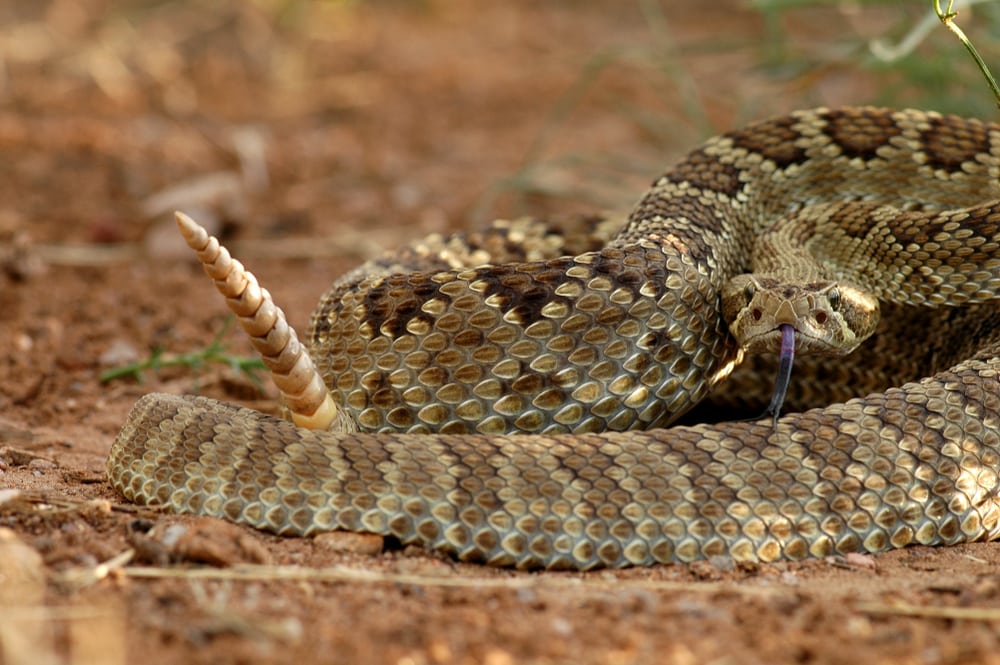
The Mojave Green Rattlesnake is the most venomous snake in the world. The scary part is that it can shoot venom even after it is long dead. The venom usually takes a while before it sets in, giving humans a false safety feeling.
This species makes its home on mountain slopes and desert areas and lives in the Southwestern part of Utah. You can recognize this snake by its green coloring with dark diamond patches on its back.
This snake is active during the warmer months from April until September and it hibernates for the rest of the year.
6. Speckled Rattlesnake
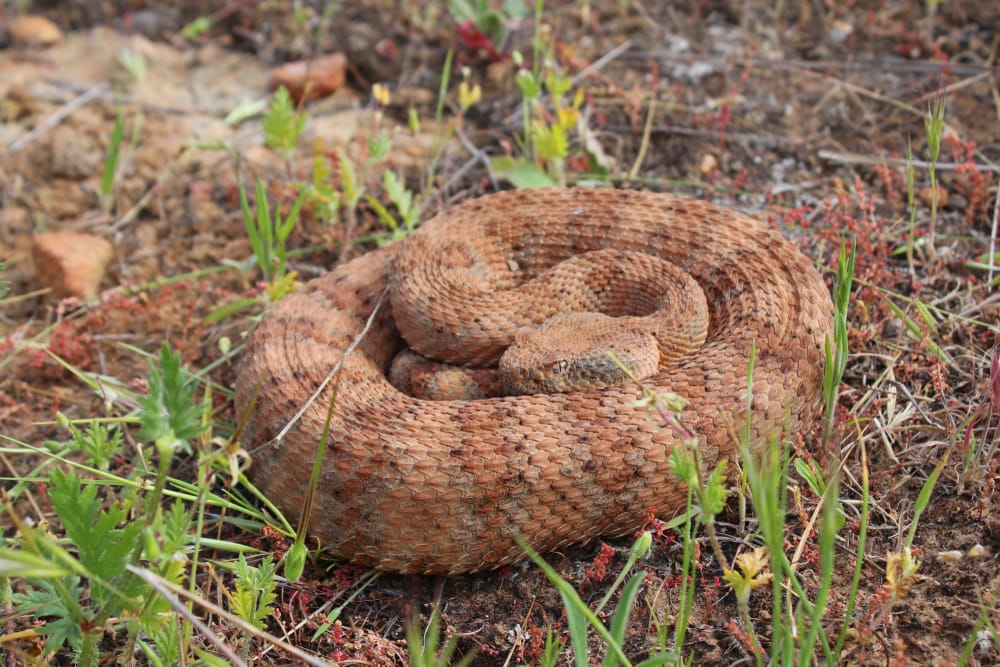
The Speckled Rattlesnake is named after the American physician Silai Weir Mitchell. This species usually has colorings to match its environment. On its back, it has dark blotches and speckles and its tail has dark rings.
It can be found in Southwest Utah in the rocky areas so it can have a lot of options for hiding. This species feeds on mice, birds and lizards.
7. Western Terrestrial Garter Snake
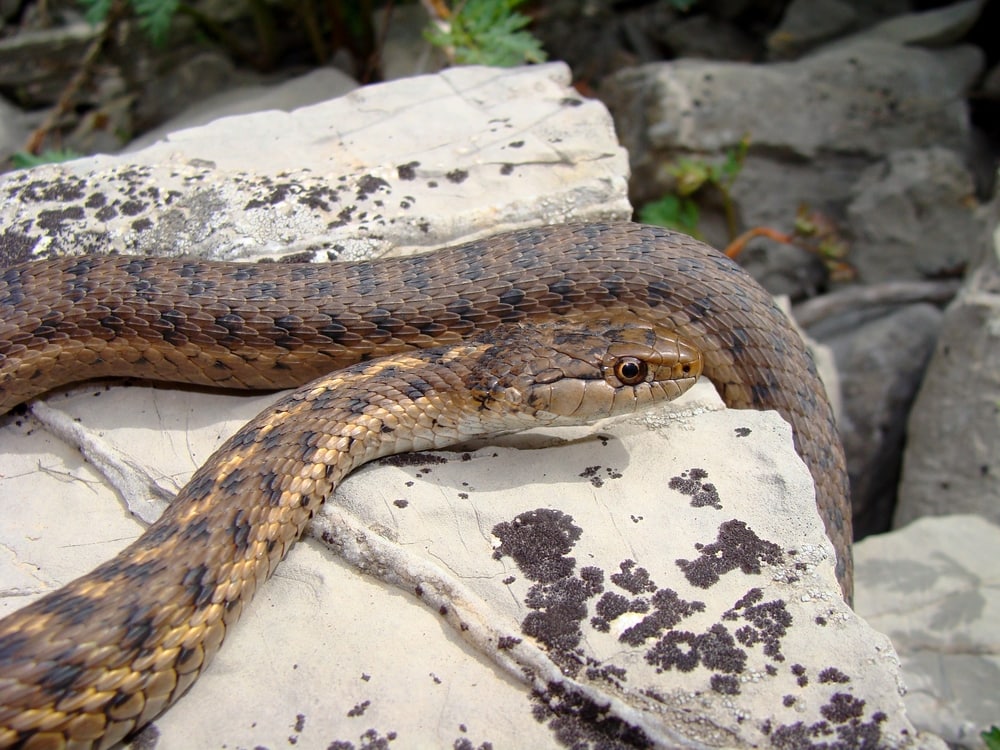
The Western Terrestrial Garter Snake is one of the hardest species to identify in Utah. They have a wide variety of colors and patterns depending on the subspecies. Here you can find the Wandering Garter Snake, and it comes in dark colors with light stripes on its back.
This garter snake lives in different habitats from grasslands, forests and mountains. They live primarily on land, but they are good swimmers as well.
This species is mildly venomous but is not harmful to humans as it can only subdue a small prey. They aren’t great hunters, and it takes them a while until they can eat their food.
You May Also Like: Discover These More Than 50 Snakes in Florida That You Should Know About with Photos, Infographics, Facts, and more!
Non-venomous Snakes in Utah
8. Sidewinder
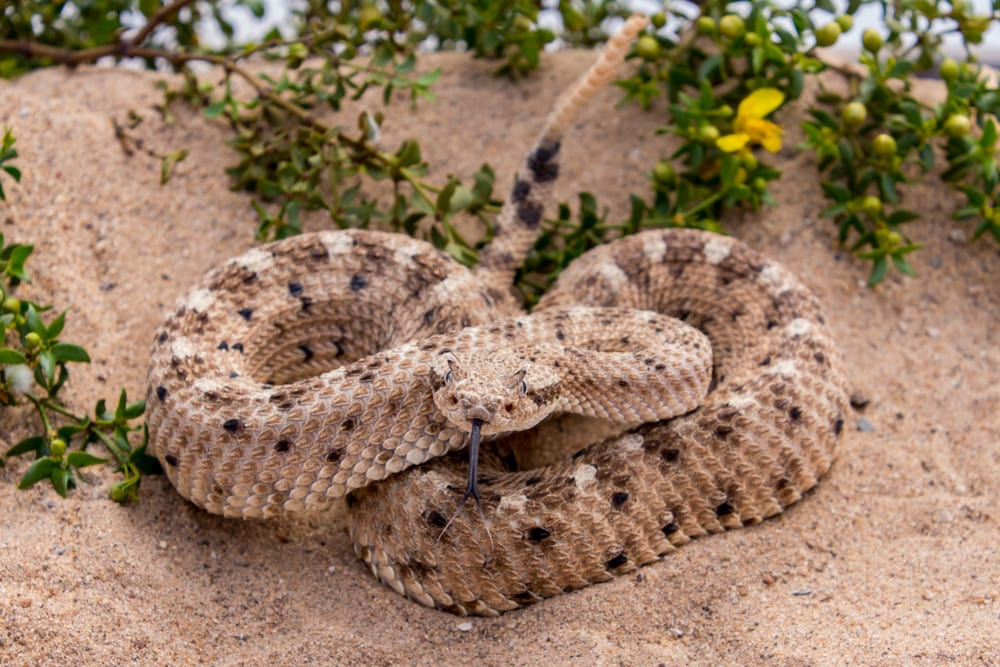
The Sidewinder snake has its particular name because of the way it moves. The snake’s body makes an S shape when it moves, and it only moves sideways. Their movements adapted to their environment, as the S movement works wonders on the sand, as they live in desert areas.
Another way you can identify this snake is by its horns. They have small horns above their eyes. The purpose of the horns is to protect the eyes from the sand.
9. Rubber Boa
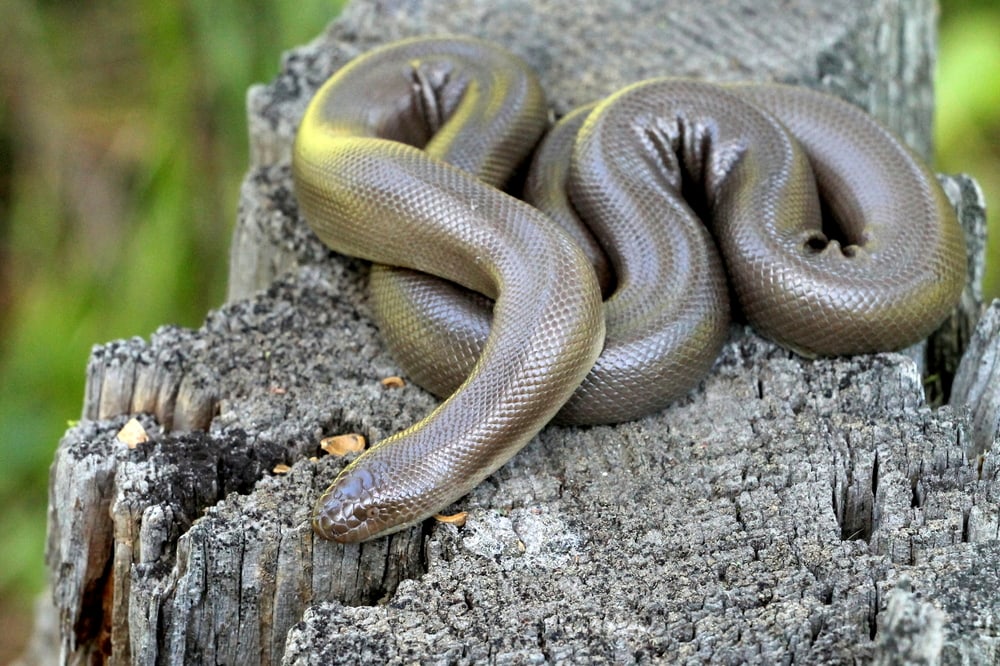
The Rubber Boa actually looks like rubber because it has shiny scales, and it feels like rubber when you touch it. They can be brown or gray, and their belly will be a lighter color.
This snake hates warm weather and loves the cold. They can live at 54℉ (12°C) . They are a shy species and stay mostly under rocks and foliage. Usually people have them as pets and sometimes they are used to help people overcome their fear of snakes.
10. Sonora Mountain Kingsnake
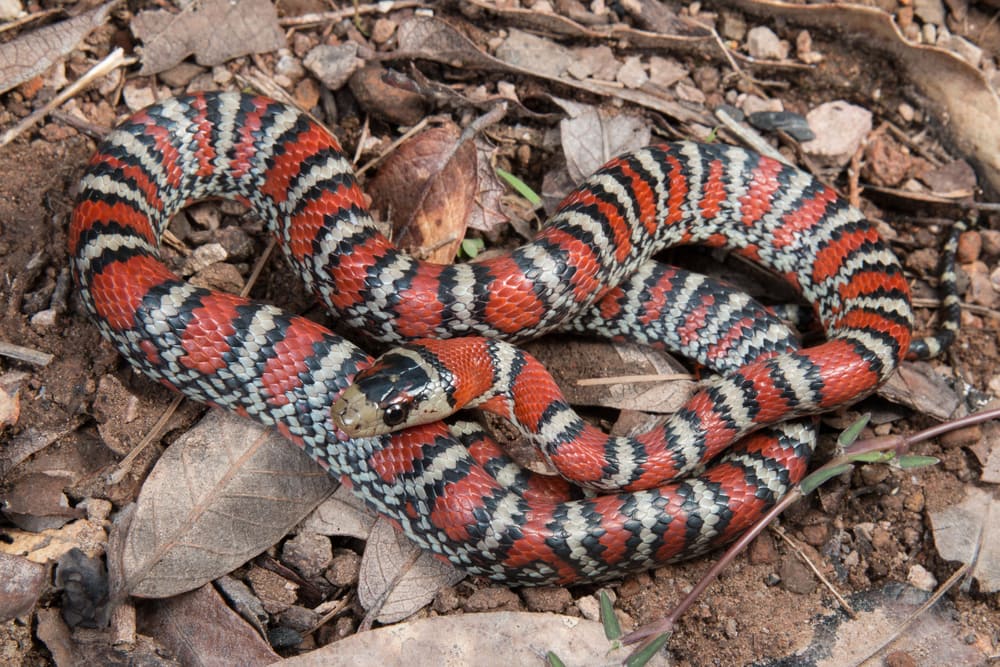
The Sonora Mountain Kingsnake has the most beautiful colors and patterns. Its body alternated with red, black, and white rings, while its head is black with a yellow snout.
What’s interesting about this snake is that it releases a foul odor when it feels threatened. Kingsnakes eat other snakes, and they love to eat venomous snakes because they are immune to the venom. They also eat small mammals and lizards and usually subdue them by constructing them.
11. Striped Whipsnake
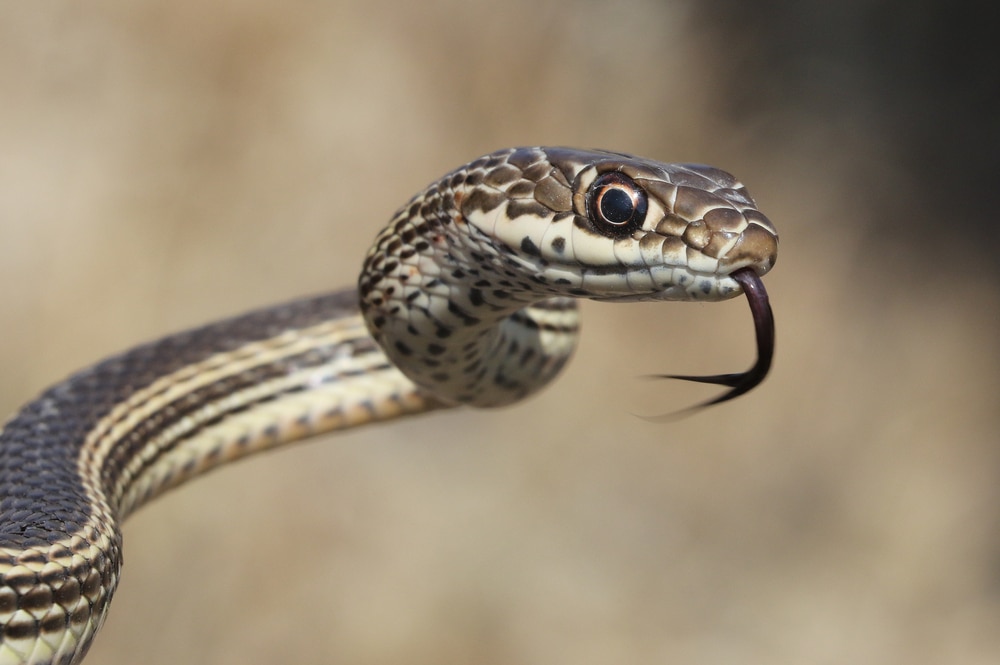
The stripes make the snake, or at least the Striped Whipsnake. More so, it looks like a long and dangerous whip. Their base color is dark, with light stripes along its body. These cold-blooded animals live in habitats like grasslands, canyons, woodlands, and rocky hillsides.
They like to eat rodents, reptiles, insects, and birds, and as a method of hunting, they usually stalk or ambush their food.
12. Desert Night Snake
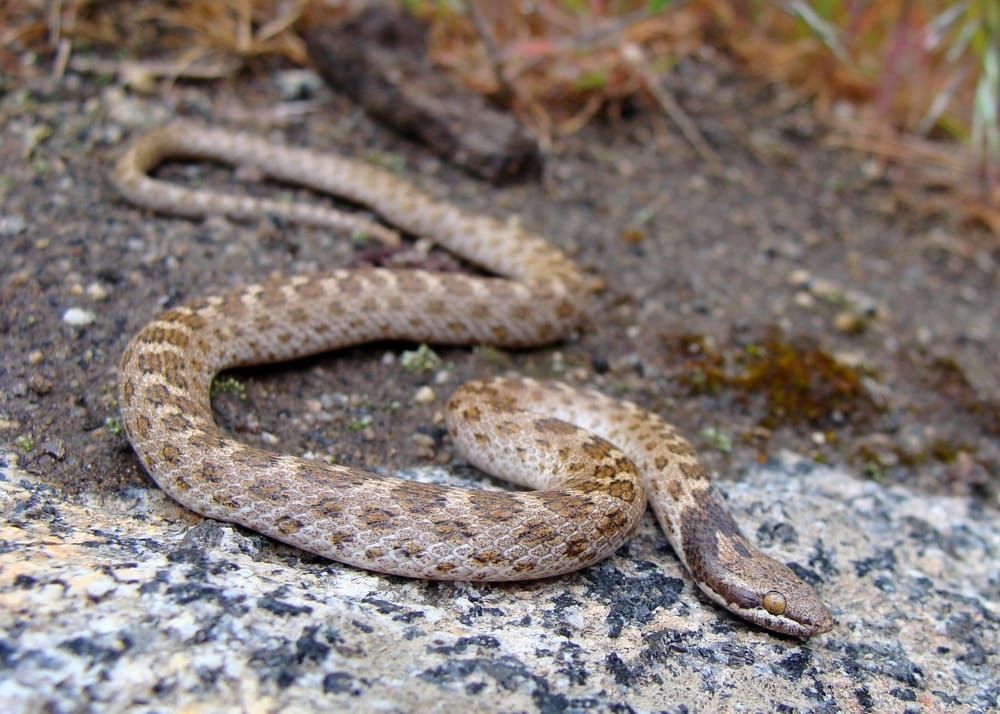
As the name foretold, the Desert Night Snake lives in arid habitats with rocks where they can hide. They are great night hunters that go for lizards, scorpions and small animals. They are mildly venomous but not harmful to humans. These snakes don’t usually attack people, and when they feel threatened, they just curl into a ball.
13. Night Snake
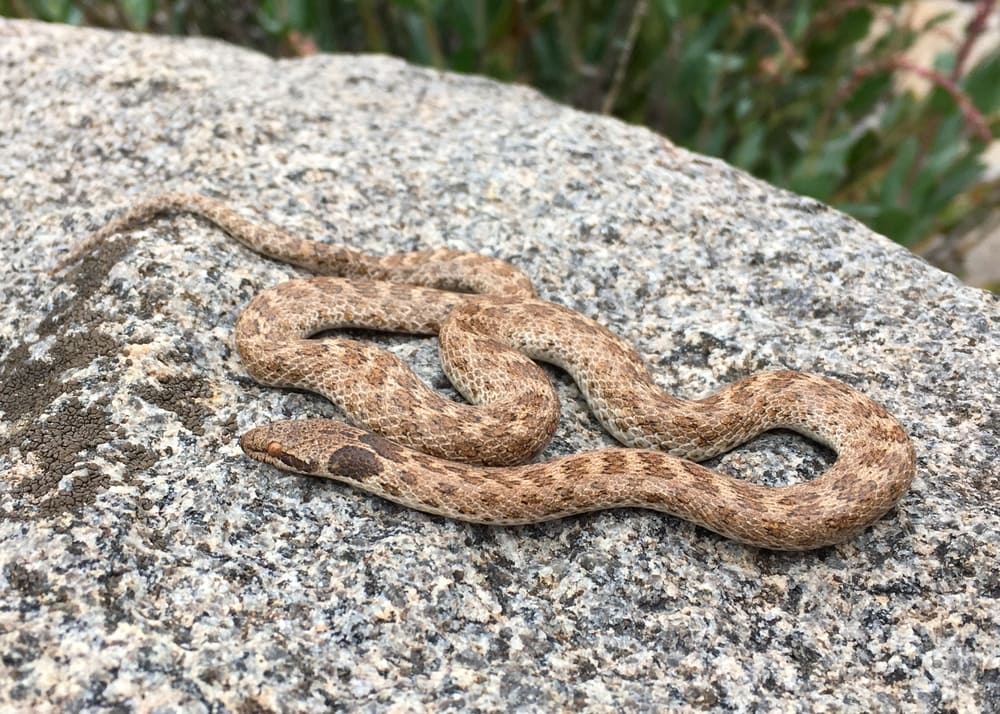
The name is a dead giveaway for when this snake prefers to hunt. They hunt at night and hide during the day. Their favorite food is birds of prey, such as hawks and owls. This snake is mildly venomous but only for small animals.
Night snakes aren’t as easy to recognize as they are dark or brown with saddle-shaped blotches. Their head is darker than the rest of its body.
14. Long-nosed Snake
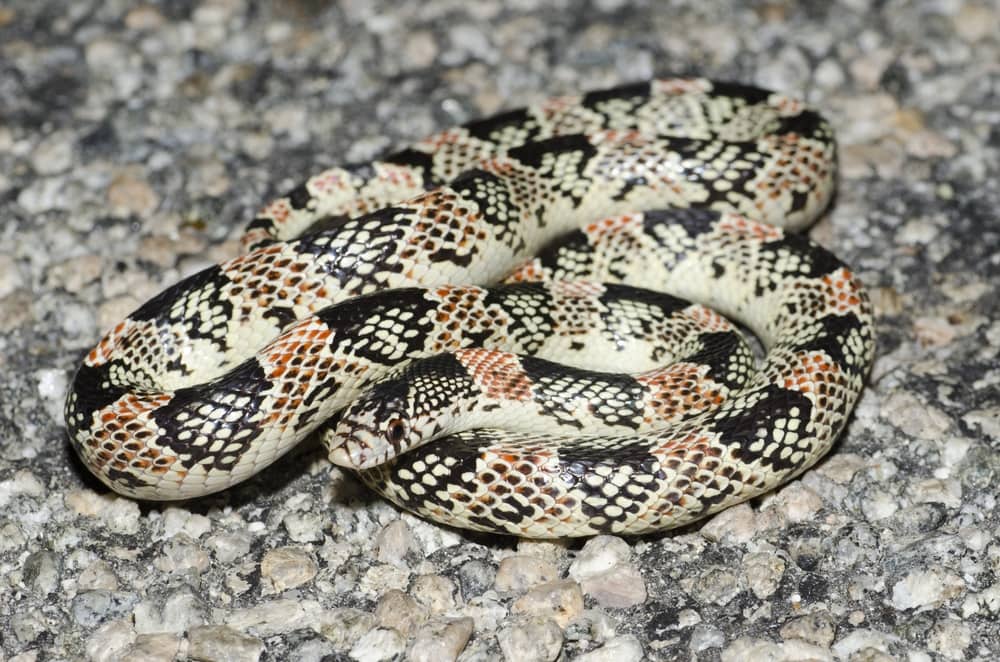
The Long-nosed Snake earned its name because of its long snout. You can identify this snake by its interesting coloring as it has red and black bands with yellow spots between. This snake is not venomous, but it does release a foul odor when it feels threatened. Sometimes it also bleeds from its cloaca as either a defense mechanism or when it sheds.
15. Western Blind Snake
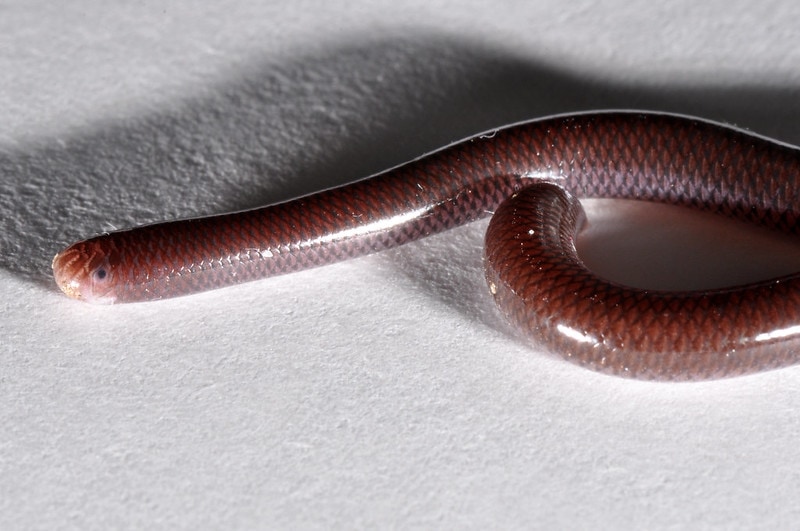
This species is a combination between a worm and a snake. Its’ color is a shade of light pink. Overall, it looks like a large worm, with one scale on its head. This snake spends most of its time underground. Because of this, it lost its ability to see, and it is blind.
He usually eats ants, termites, and their larvae and eggs. As a defense mechanism, he releases a foul odor from his cloaca, or it plays dead.
16. Western Patch-Nosed Snake
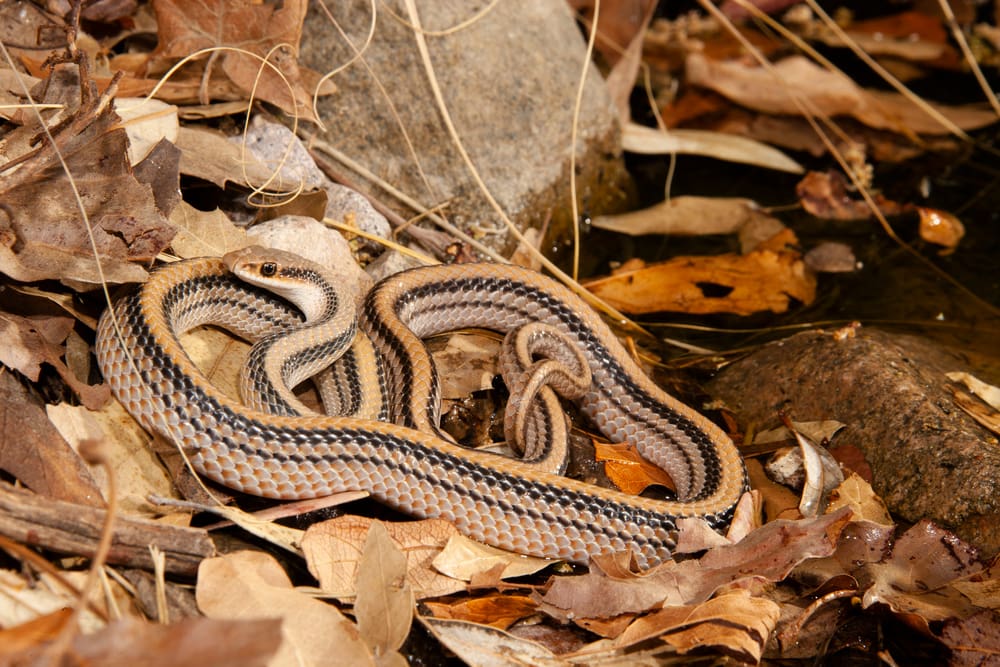
The Western Patch-Nosed Snake has a distinct look, hence the name. It has a patch-like scale on its nose that helps him dig for lizard eggs. In Utah, this snake can be found in the southwestern parts.
This snake is usually not a threat to humans, and he is active during the day. It prefers to live in semi-arid areas because it has soft soil, so it can dig easily.
17. Western Ground Snake
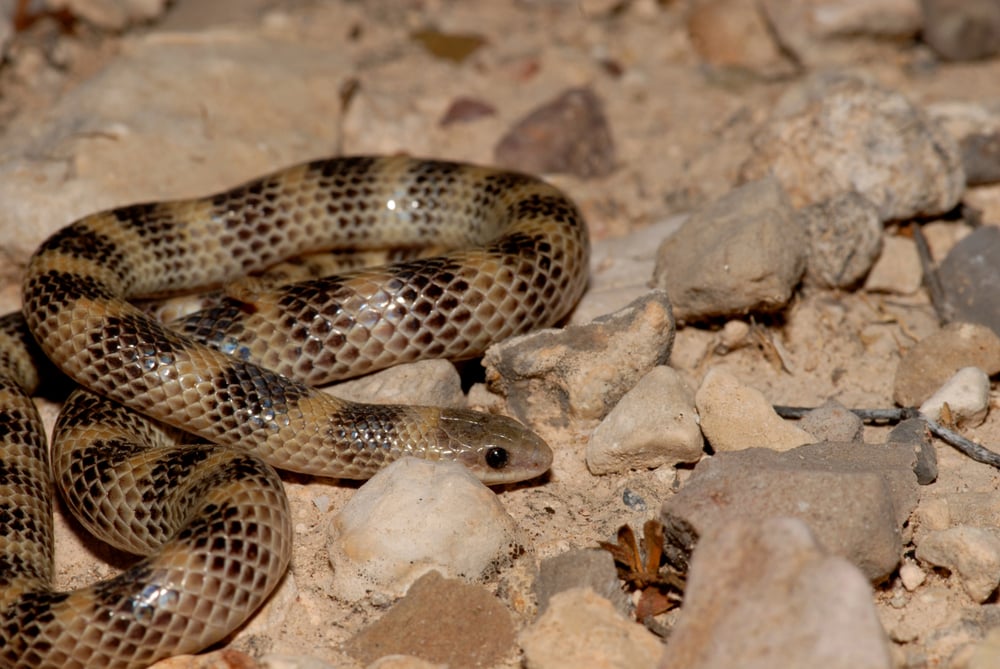
The Western Ground Snake has a variety of colors and patterns, so he also has the name Variable Ground Snake. It can be beautifully colored with orange, brown, or red with different colors for bands and stripes.
This species lives in the dry, rocky hillside areas. This is useful for the snake because it is easier to hide. Unlike the patch-node snake, this one is active during the night, and he hunts spiders, centipedes, and crickets.
18. Gopher Snake
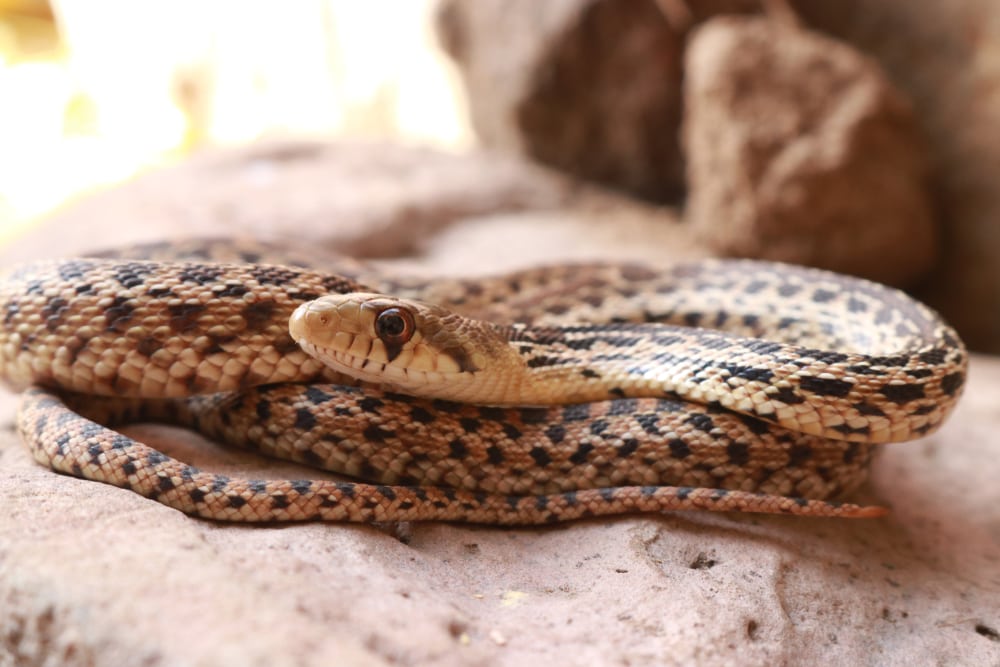
The Gopher Snake has a brown chain-like pattern on its back with dark blotches. This snake can channel other snakes and transforms itself into a pit viper if it needs to defend itself. It sometimes strokes its tail into the foliage to make the rattle sound, fooling the predators that he is a rattlesnake.
This species lives in the Great Basin and it lives on land, on water, and it is a great climber. The Gopher snake got its name from his favorite food, the gophers
19. Smith’s Black-Headed Snake
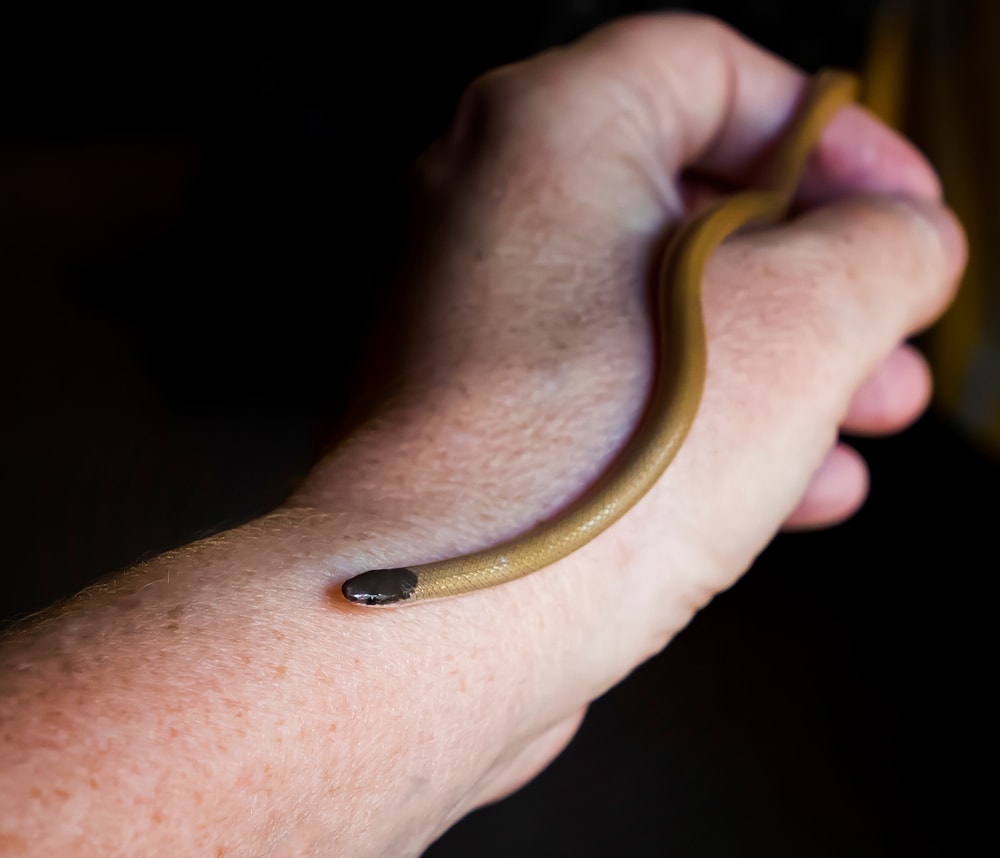
This snake has a blackhead while the rest of the body is a light shade without markings. On its belly, it has a pink strip that starts from its head right to its tail. He is named after Hobart Smith, a zoologist whose job was to describe amphibians and reptiles in America.
The black-headed snake lives underground and is nocturnal. It has venomous saliva and is used to kill insects. This snake’s venom is not harmful to humans or mammals.
20. Glossy Snake
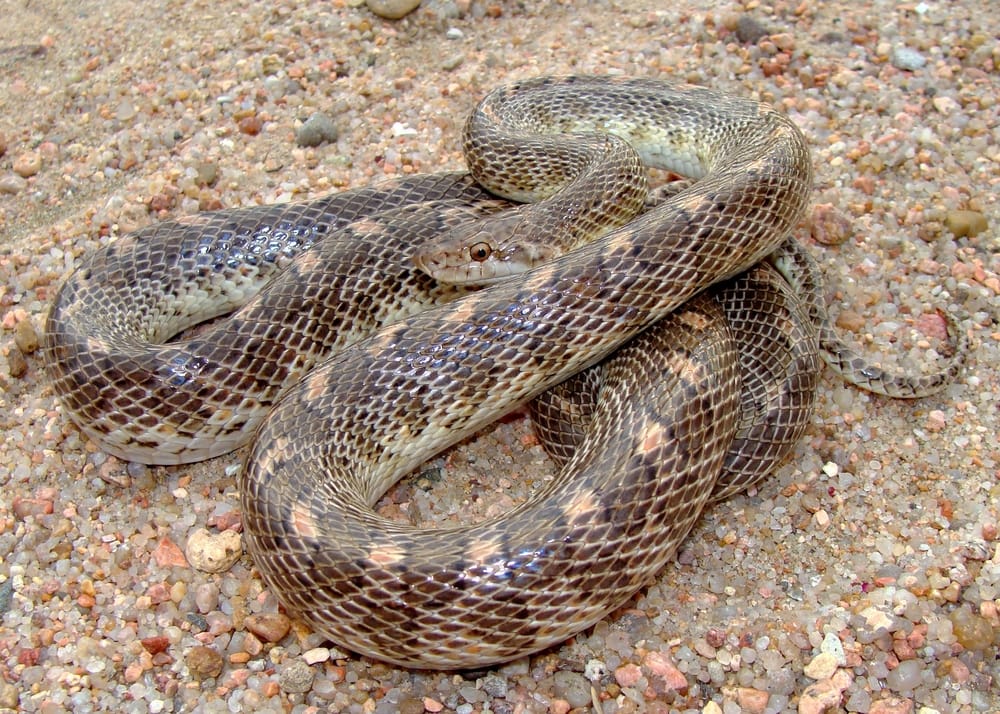
The Glossy Snake is similar to the Gopher Snake. This one also pretends to be a rattlesnake while striking its tail on foliage. Unlike the previous snake, which only does this, the Glossy snake also attacks its predators.
In terms of look, this snake is smaller than the Gopher species and he has a longer snout. It is not venomous, so his bite is not that harmful. Strangely enough, this snake likes to live in basements and attics.
21. Western Lyre Snake
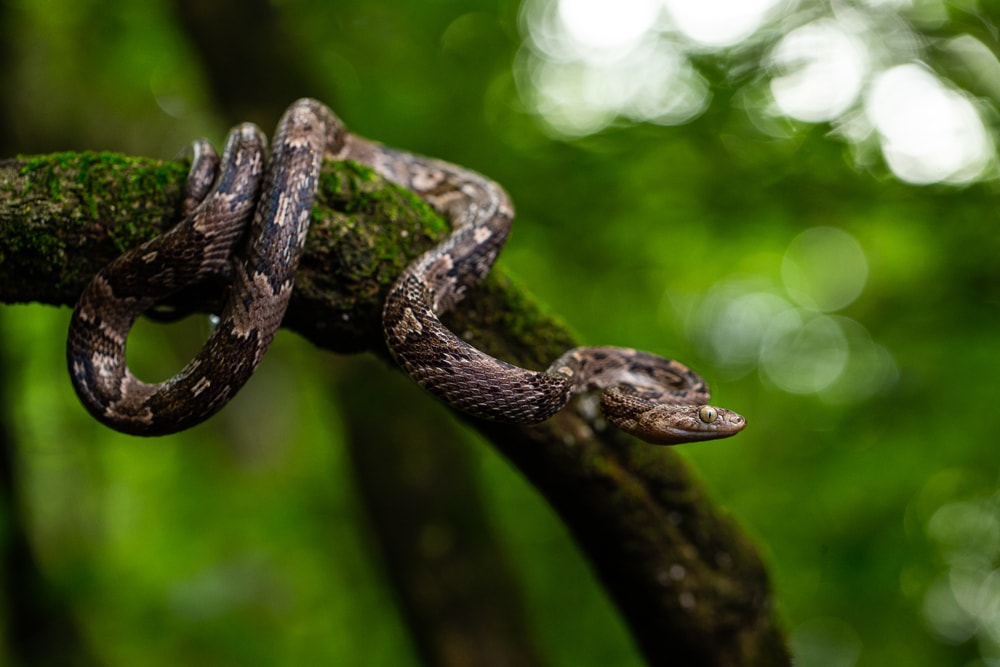
The Western Lyre Snake is a medium-sized snake with beautiful pattern dark blotches, and it comes in brown or gray colors. What sets this snake apart is his really big eyes. It looks like he can hypnotize you.
This species is mildly venomous, but it only works on lizards. It has no effect on humans or other mammals. This intelligent snake also uses the technique of mimicking a rattlesnake to defend itself. It can be found in the southern part of Utah.
22. Great Plains Rat Snake

The Great Plains Rat Snake is usually gray with dark blotches. It’s pattern on his head is very interesting as it has two lines that meet in the middle of his head, right between his eyes. His belly looks like a chessboard in black and white.
This snake is not venomous, but it is aggressive, especially during mating season. It also mimics a rattlesnake and can release a foul odor.
It feeds on rodents, birds and bird eggs, reptiles, and other snakes.
23. Ring-Necked Snake
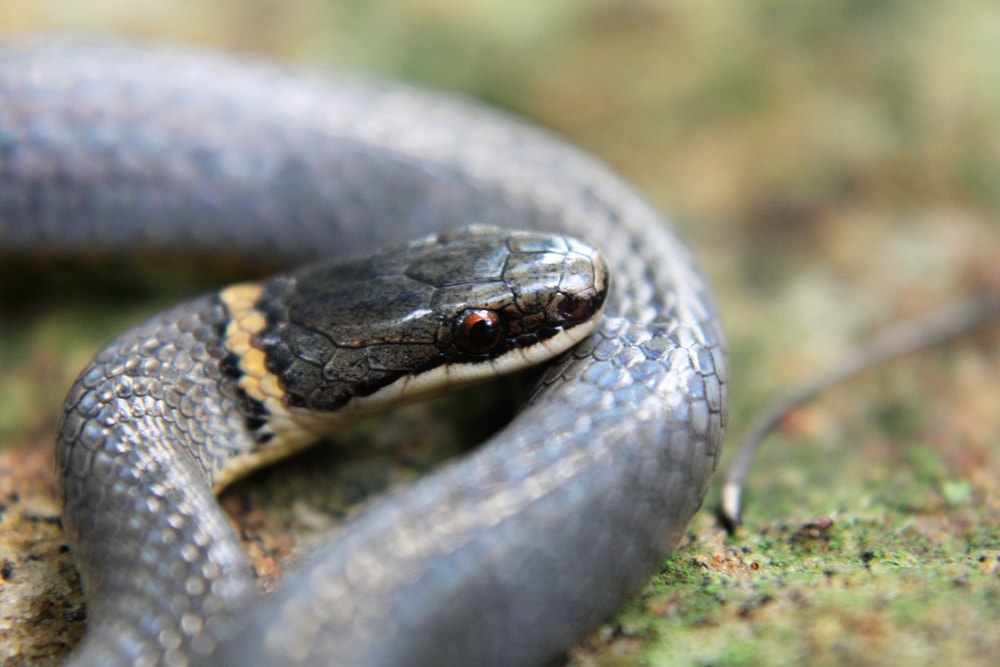
With no surprise, the Ring-Necked Snake has a light-colored ring around its neck, while the rest of its body has a dark color. It is venomous, but it only uses this for feeding. This snake constricts its prey, bites it, and then eats it entirely. His dark coloring helps it blend in with the background.
24. Sonoran Lyre Snake
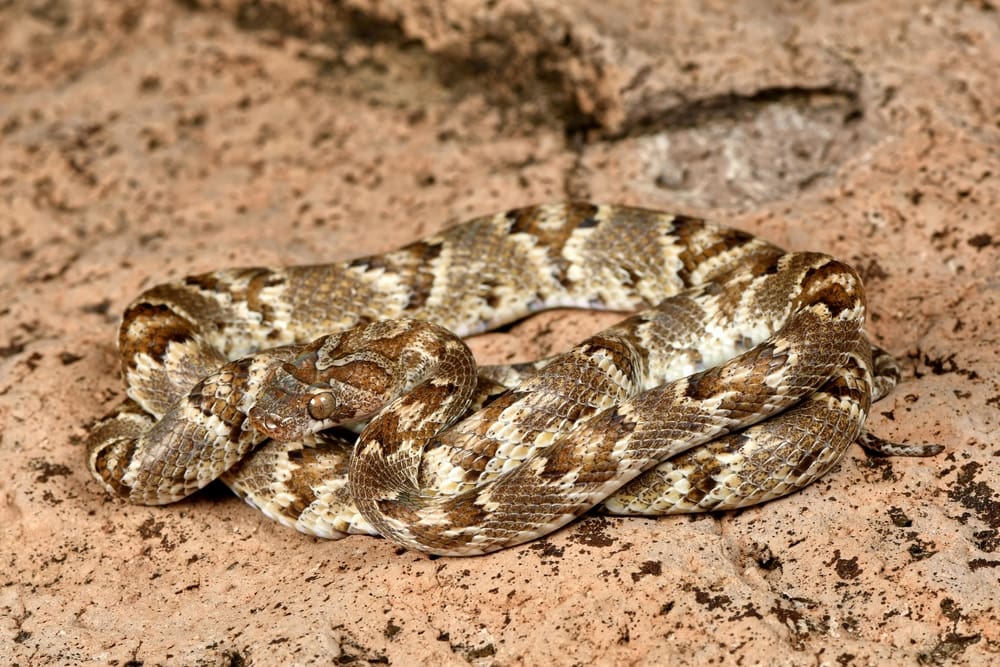
The Sonoran Lyre Snake is mildly venomous, exactly like the Western Lyre Snake. Its venom is not potent enough to properly harm humans, but it can cause swelling and numbness.
This species has its particular coloring to blend in with its rocky habitat. The snake has a tan base color with darker tan blotches and white patches.
Like most snakes, the Sonoran Lyre snake is nocturnal and likes to feed on lizards, small mammals, birds, or other snakes.
25. Spotted Leaf-Nosed Snake
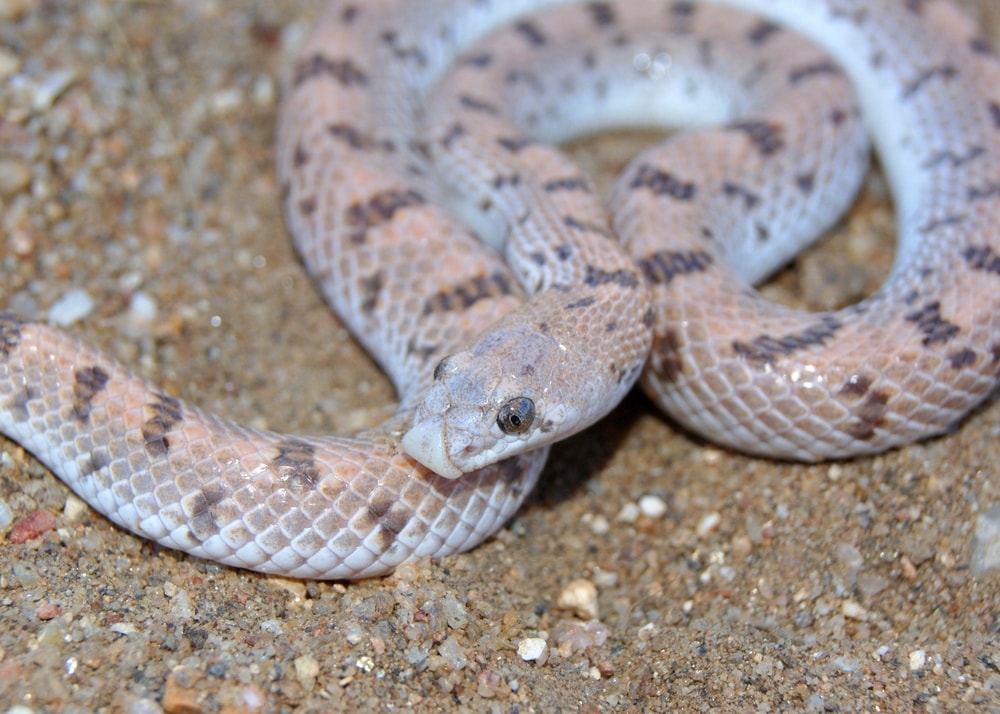
The Spotted Leaf-Nosed snake has such a unique nose shape that almost looks like a leaf, hence its name. It is a really tiny snake with pale colors and barely-noticeable darker blotches.
This species is quite shy, likes to hide, and is nocturnal. This snake prefers sandy habitats where it can easily dig with its strangely shaped nose. You can find it in the southwestern parts of Utah.
Like any other snake, it likes to feed on lizards and their eggs.
26. Black-Necked Garter Snake
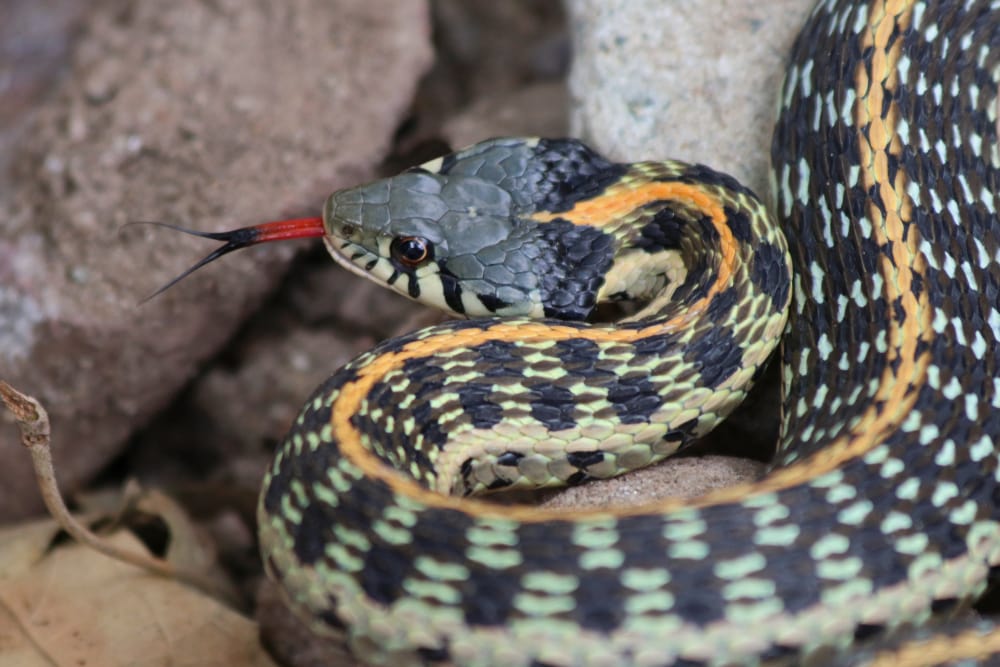
This snake has a really gorgeous pattern. Its base color is grey with dark gray blotches, tan lines running across its body, and on its neck, it has two big dark blotches that gave its name.
This species is semi-aquatic, so it likes to live near water. It feeds on fish and amphibians but can also eat other small animals and snakes.
27. California Kingsnake
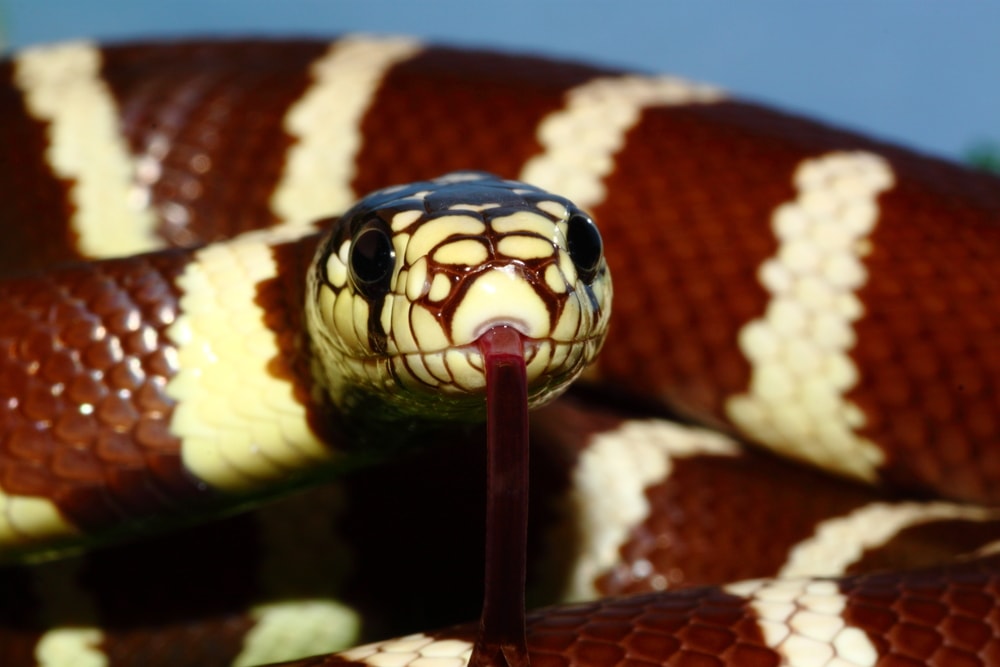
The California Kingsnake is distinguishable by a series of yellow and brown bands. This snake frequents people’s homes, but it is not harmful as it is nonvenomous. If it feels threatened it will bite, so it’s best to leave this snake to its business.
This species has a strong bite and is comparable to a Burmese python. They usually like to squeeze the air out of lizards, their preferable food.
28. Eastern Racer
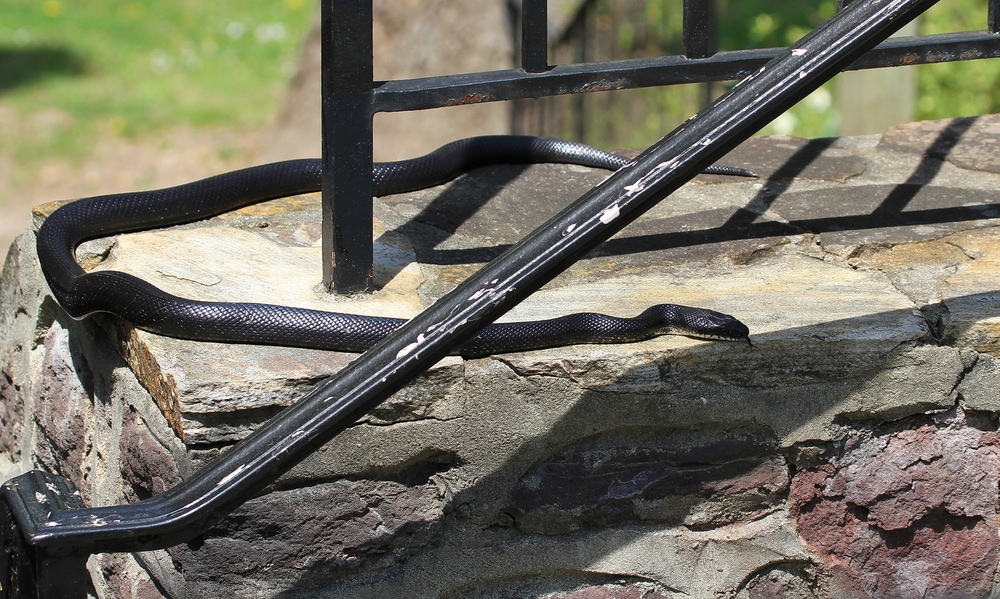
The Eastern Race has its name due to its very fast movement on land. They are an aggressive type of snake, and if they are threatened, they will attack. They sometimes even attack people’s dogs or humans if they wander into its territory.
The Eastern Racer subspecies found in Utah is called the Mormon Racer, and it is very long and thin with a yellow belly. The base color is a dark grey or dark green tone.
29. Coachwhip
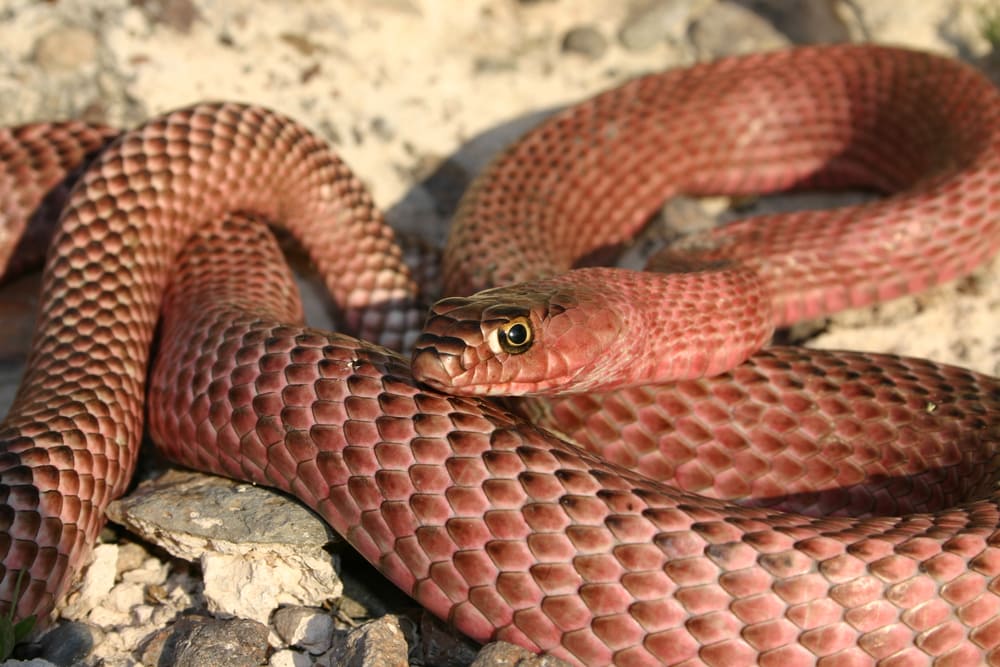
This is probably the most diverse-looking snake on this list because of its reddish coloring. It has a very long thin body that resembles a whip. This snake is also called the red racer because it moves so fast that it is also the fastest snake in America.
The Coachwhip snake is a diurnal species and likes warm temperatures. They are non venomous and feed on lizards, snakes, and other small animals. When they are threatened, they usually flee because they are the fastest.
30. Smooth Green Snake
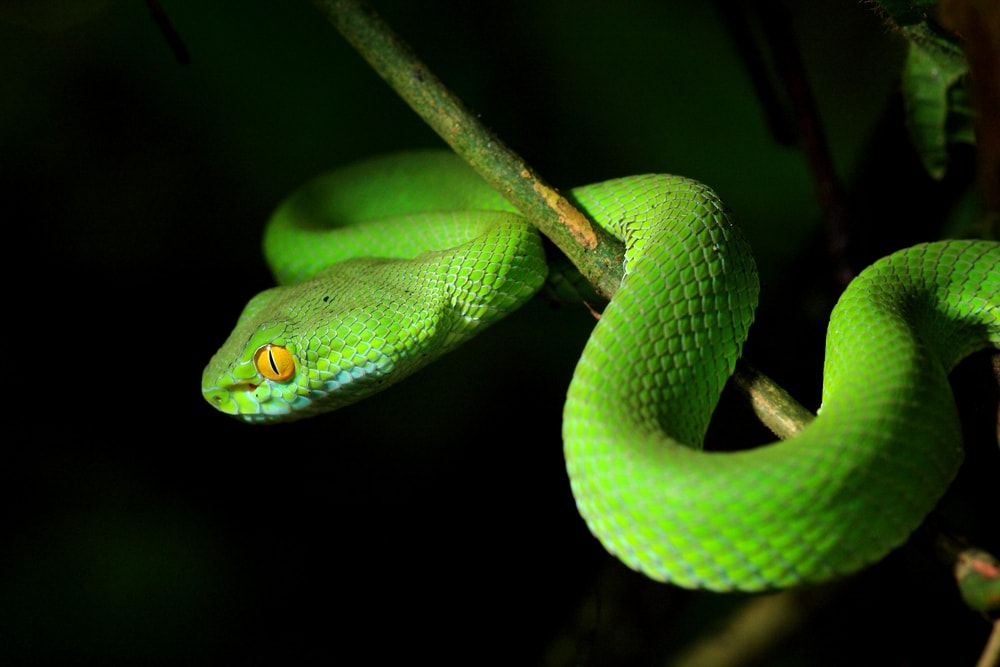
The Smooth Green Snake has a very bold green color and unkeeled scales. The baby snakes are born with grey skin, and with their first shedding, they get their green color. Their bright green blends perfectly with its environment full of foliage and helps it stay hidden from predators.
This snake likes to eat plenty of insects, moths, caterpillars, ants, and spiders. It usually swallows its prey in one bite. These are calm species of snakes and don’t attack. Its predators include birds of prey, some mammals, and other snakes.
This snake is on the verge of losing its natural habitats due to extensive urbanization and pesticides.
31. Milk Snake
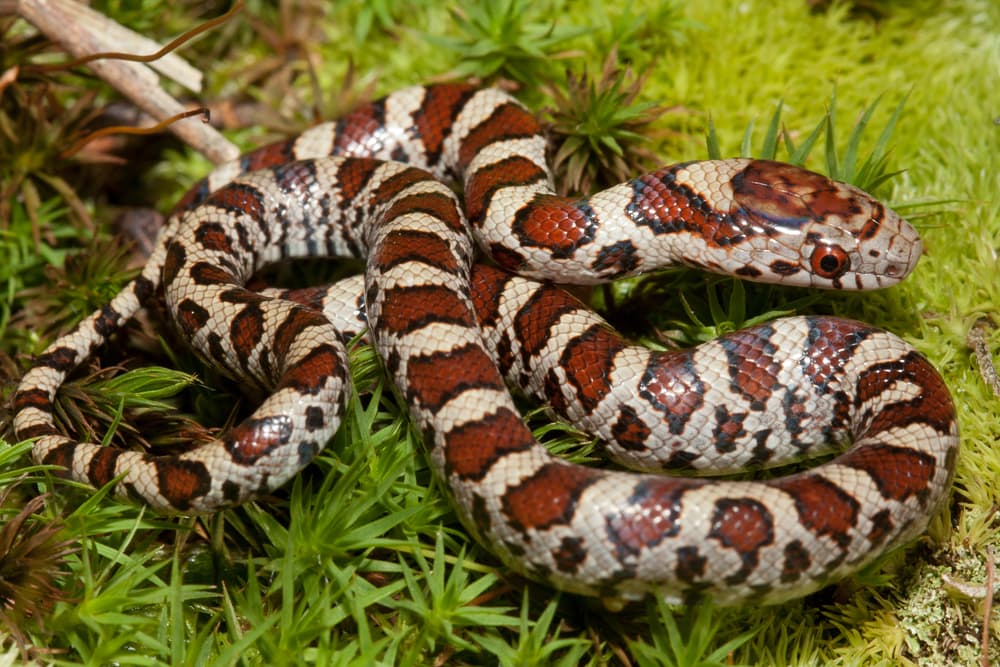
The Milksnake belongs to the kingsnake genus. Its coloring combines three bands of white, red, and black. You can find two subspecies in Utah; the Utah Milk Snake and the Central Plains Milk Snake.
They like to feed on slugs, worms, and lizards. They also go for birds and bird eggs or other snakes, including poisonous ones, because they are immune to their venom.
You can spot these snakes on farms, in barns. These snakes are not fans of warm weather, so they prefer to hide in cold environments. They got their name because people used to say they feed on cow milk. This is completely false.
You May Also Like: Make Sure To Check Out These 14 Snakes in Virginia Complete with Facts, Infographics, Photos, and more!
FAQ
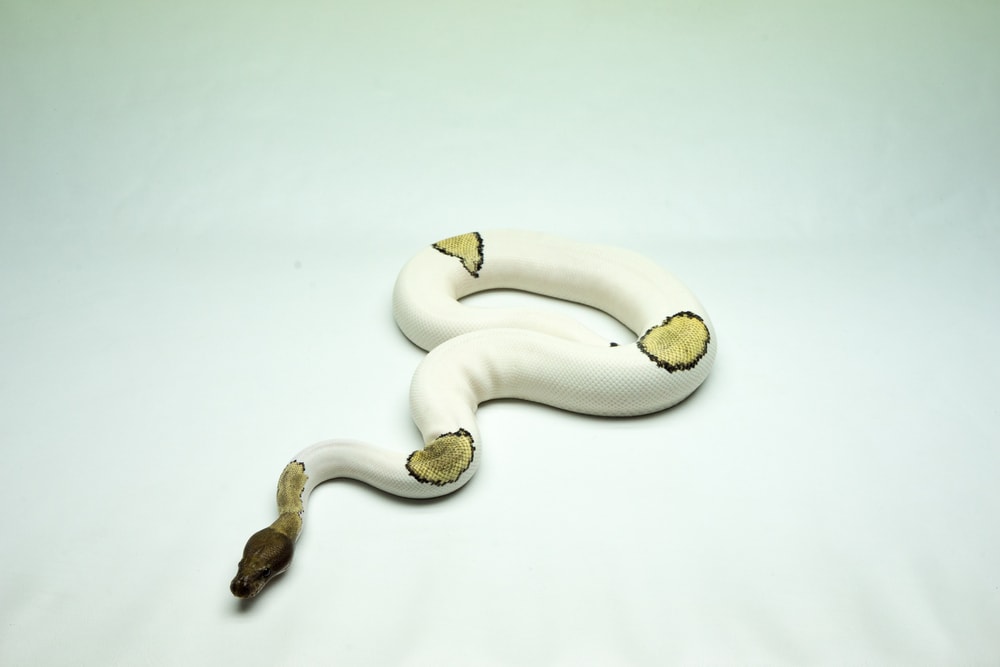
1. Are snakes common in Utah?
Utah is called the Snake Country because it is the home of several species of snakes, some are venomous, and some present no harm to people. Snakes can be found all over this state, and some species sneak into people’s homes.
2. What do you do if you encounter a rattlesnake?
If you encounter a rattlesnake outside, it is best to leave it alone. Never try to poke, handle, or harass a snake. This will make it attack you. Never throw anything at the snake, as it will make it feel threatened. Turn away from the snake and walk the other way.
3. What is the most dangerous snake in Utah?
All venomous snakes in Utah are dangerous, so it is best to avoid crossing their paths. The Mojave Green Rattlesnake is the most venomous snake found in Utah. Its venom contains neurotoxins that attack the nervous system and hemotoxins that attack the blood.








